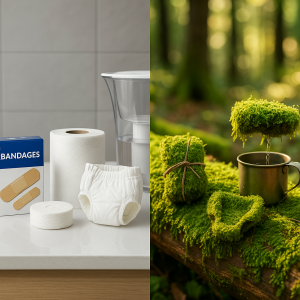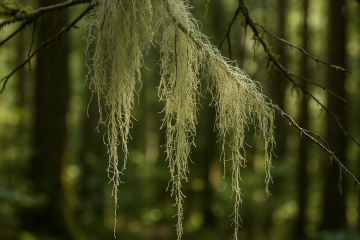
What else can MOSS replace in your world in a crisis?
If you’ve ever strolled through a forest barefoot, you know that moss feels like nature’s version of a freshly fluffed bath mat — soft, cool, and quietly confident about it. But that plush green carpet isn’t just there to make fairies feel fancy. For centuries, moss has been the unsung hero of hygiene — absorbing spills, healing wounds, and even filtering water — all without a single marketing campaign or eco-label. It’s soft, it’s free, it’s antibacterial, and frankly, it’s been waiting for humans to remember just how brilliant it really is.
Let’s crack the “Moss Code,” shall we?
The OG of Absorbency
Before there were brand wars over “ultra-absorbent” and “triple-quilted” products, there was moss. Indigenous tribes, Vikings, and even medieval healers knew that sphagnum moss could soak up twenty times its weight in liquid. (Eat your heart out, paper towels.) It was nature’s Charmin — soft, free, and found in the nearest bog instead of aisle seven.
During World War I, nurses used sterilized sphagnum moss in battlefield bandages because it didn’t just absorb — it fought bacteria too. Soldiers’ wounds healed cleaner and faster, thanks to moss’s natural acidity and antimicrobial properties. Translation? Moss doesn’t just look like a fuzzy green miracle… it acts like one.
Diaper Duty, Pioneer-Style
Let’s be honest — babies don’t care about brand names either. Native Alaskans and Scandinavian families once used moss as makeshift diapers, wrapping it in animal skin or cloth to keep little explorers dry. Why? Because moss wicks moisture away better than a modern-day yoga influencer sipping celery juice.
And here’s the kicker: moss is biodegradable, compostable, and smells faintly like the earth after rain — not “Mountain Meadow Blast” or whatever marketing invented. If society ever finds itself short on Pampers again, just remember: the forest has your back (and your baby’s bottom).
Nature’s Green Brita Filter
Turns out moss isn’t picky about where it helps out. From Arctic explorers to Pacific Northwest homesteaders, many used moss as a natural water filter. While it’s not a replacement for boiling or chemical purification, it can help trap debris and sediment — a handy trick if your modern gear takes a swim downriver.
Some survivalists still pack dried moss in a filter layer when building emergency purifiers. It’s absorbent enough to catch the “floaties,” and antibacterial enough to make you feel less like you’re sipping pond soup.
Moss: The Original Wet Wipe
Modern preppers love a good multi-use item. Moss checks every box — soft enough to clean with, effective enough to dress wounds, and abundant enough to never run out. No electricity, no expiration date, and no guilt about flushing it. It’s practically the perfect post-apocalypse spa treatment.
When you’re out in the wild, sphagnum moss works as a gentle cleanser for hands, faces, or other areas that have lost their polite scent. (Just make sure it’s clean and not growing over something unspeakable. Even moss has boundaries.)
A Gentle Reminder (and a Little Introspection)
Moss teaches a lesson modern self-reliance sometimes forgets: that solutions don’t have to be complicated to be effective. Nature has been running her own zero-waste operation for millennia. While we invent gadgets that need charging, moss just exists — quietly cleaning, filtering, and healing without a single press release.
So next time you step on that soft green carpet, give it a nod of respect. It’s not just decoration. It’s proof that the best survival tools are often the ones we’ve been stepping over — literally — for generations.



0 Comments